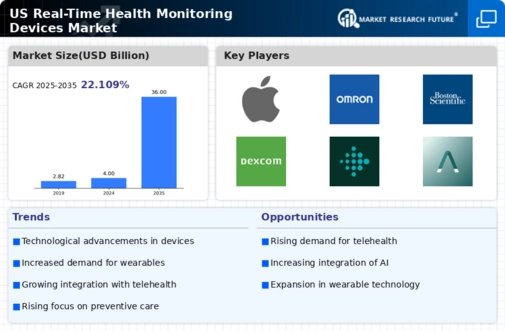Increased Focus on Preventive Healthcare
The shift towards preventive healthcare is a significant driver for the real time-health-monitoring-devices market. As healthcare costs continue to rise, there is a growing emphasis on preventing diseases rather than treating them. This proactive approach encourages individuals to monitor their health regularly, leading to increased adoption of real time-health-monitoring-devices. According to recent studies, nearly 70% of consumers express interest in using wearable devices for health monitoring. This trend is likely to propel the market forward, as more individuals seek to take control of their health. Healthcare providers are also recognizing the value of these devices in promoting preventive care, which may further drive their integration into standard healthcare practices.
Growing Demand for Chronic Disease Management
The rising prevalence of chronic diseases in the US is a primary driver for the real time-health-monitoring-devices market. As conditions such as diabetes, hypertension, and heart disease become more common, patients and healthcare providers increasingly seek effective monitoring solutions. The market is projected to reach approximately $20 billion by 2026, reflecting a compound annual growth rate (CAGR) of around 25%. This demand is fueled by the need for continuous health tracking, enabling timely interventions and personalized care. Consequently, healthcare systems are investing in real time-health-monitoring-devices to enhance patient outcomes and reduce hospital readmissions. The integration of these devices into everyday healthcare practices is likely to transform chronic disease management, making it more proactive and patient-centered.
Technological Advancements in Device Capabilities
Technological innovations are significantly influencing the real time-health-monitoring-devices market. Advances in sensor technology, connectivity, and data processing capabilities are enhancing the functionality of these devices. For instance, the introduction of advanced biosensors allows for more accurate and real-time data collection, which is crucial for effective health monitoring. The market is expected to grow as manufacturers invest in research and development to create devices that offer improved accuracy and user experience. By 2025, it is estimated that the market will witness a surge in demand for devices capable of monitoring multiple health parameters simultaneously. This trend indicates a shift towards more comprehensive health management solutions, which could lead to better health outcomes for users.
Rising Consumer Awareness and Health Consciousness
Consumer awareness regarding health and wellness is on the rise, significantly impacting the real time-health-monitoring-devices market. As individuals become more health-conscious, they are increasingly seeking tools that enable them to monitor their health metrics effectively. This trend is evident in the growing popularity of fitness trackers and smartwatches, which are now commonplace among health-conscious consumers. Market Research Future indicates that the wearable health technology segment is expected to grow by over 30% in the next few years. This heightened awareness is likely to drive demand for more sophisticated real time-health-monitoring-devices, as consumers look for features that provide comprehensive health insights and facilitate better lifestyle choices.
Supportive Regulatory Environment for Health Technologies
A supportive regulatory environment is fostering growth in the real time-health-monitoring-devices market. Regulatory bodies in the US are increasingly recognizing the importance of these devices in enhancing patient care and are streamlining approval processes for innovative health technologies. This regulatory support encourages manufacturers to invest in the development of new devices, knowing that they will have a clearer pathway to market entry. As a result, the market is expected to expand, with more innovative solutions becoming available to consumers. The FDA's recent initiatives to expedite the review of digital health technologies indicate a commitment to promoting advancements in the real time-health-monitoring-devices market, which could lead to a broader range of options for consumers.























Leave a Comment